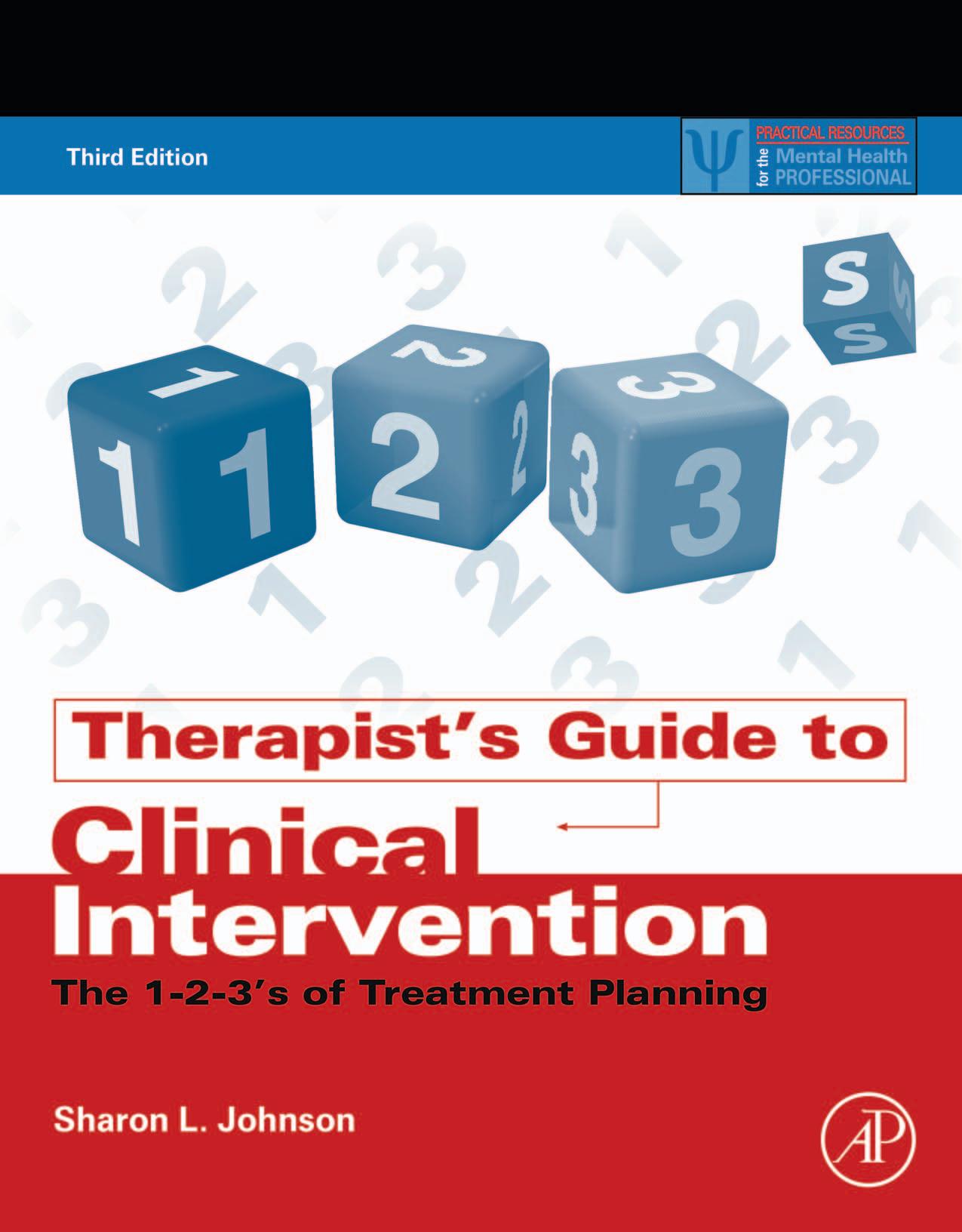Personality
https://ebookmass.com/product/personality-psychology-domains-ofknowledge-about-human-nature-2nd-cdn-ed-edition-randy-j-larsen/
ebookmass.com
CONTENTS
Introduction xix
Level of Patient Care and Practice Considerations xxi
Decision Tree of Evaluation and Intervention xxiii
Levels of Functioning and Associated Treatment Considerations xxiv
High-Risk Situations in Practice xxv
Treatment Plan xxvi
Solution-Focused Approach to Treatment xxvii
Case Conceptualization xxviii
Common Diagnoses and Associated Codes xxx
Behavioral Health Code Crosswalk From DSM to ICD-10 xxx
Common DSM “V” Codes xxxii
Chapter 1
TREATMENT PLANNING: GOALS, OBJECTIVES, AND INTERVENTIONS
Neurodevelopmental Disorders 2
Intellectual Disability 2 • Intellectual Disability 3 • Autism Spectrum Disorder 6
Disruptive Behavior Disorders 12
Attention-Deficit Hyperactivity Disorder and Oppositional Defiant Disorder 12
Impulse Control Disorders 20
Impulse Control Disorders 21
Separation Anxiety 24
Separation Anxiety 24
Pediatric Generalized Anxiety Disorder 27
Pediatric Generalized Anxiety Disorder 27
Living Situation 174 • Self-Care Skills 174
• Level of Required Assistance 174
Care of Environment and Chore Responsibilities 175
Crisis Assessment 175
Guidelines for Crisis Intervention 175 • Crisis Assessment Outline 176
Crisis Assessment, Intervention, and Traumatic Exposure 178
Traumatic Stress and Physical Injury 179
Critical Incident Stress Debriefing 181 • Screening for Survivors 182
Recovering From Traumatic Stress 182
Obsessional Disorders: An Overview 182
Assessment of Obsessional Disorders 182
Obsessional Disorders Assessment Outline 183
Cycle of Phobic Anxiety 185
Assessment of Phobic Behavior 185
Phobia Assessment Outline 186
Postpartum Depression, Anxiety, and Psychosis 188
Postpartum Psychosis 190 • Breaking the Postpartum Spiral 191
Chronic Mental Illness 192
General Guidelines for Assessing the Chronic Mentally Ill 193
Self-Care Behaviors 194
Medical Crisis Assessment and Counseling 195
Treatment Framework and Conceptualization 196 • The Central Crisis Issues 197
Dealing With the Challenges of Long-Term Illness 199
Working Through the Challenges and Fears Associated With Long-Term Illness 201
Chronic Pain: Assessment and Intervention 204
Factors Affecting the Experience of Pain 205 • Clinical Interview 205
Assessing and Measuring Pain 205
The Pain Scale 206
Pain Management Diary 206
Daily Pain Diary Worksheet 207
Daily Pain Journal 207 • Interventions for Chronic Pain 209 • Six Stages of Treatment 209 • Interventions 209
Somatic Problems: A Brief Review 211
The Patient With Psychosomatic Illness Who Has an Underlying Personality Disorder 212
Eating Disorder Screening and Assessment 213
Eating Disorders Screening Questionnaire 214
The SCOFF Questionnaire 215
The SCOFF Questions 215
The Mood Eating Scale 215
Eating History 216
Checklist of Observable Eating Disorder Behaviors 217
Eating Disorder Evaluation: Anorexia 218
Eating Disorder Evaluation: Bulimia 219
Attention-Deficit Disorder 220
Adult Attention-Deficit Disorder Screening 221
Attention-Deficit/Hyperactivity Disorder Behavioral Review (Child) 224
Substance Use Screening and Assessment 225
The CAGE and CAGE-AID Questionnaire 226 • The CAGE and CAGE-AID Questions 226
Substance Use Assessment 227
Substance Use Psychological Assessment 229
Substance Use History 231
Substance Use Disorders Withdrawal 232
Withdrawal Symptoms Checklist 232
Common Postacute Withdrawal Syndrome Symptoms 233 • Coping With Postacute Withdrawal Syndrome 233
Domestic Violence 233
The Family Systems Model of Domestic Violence 234
The Cycle of Violence 235
The Domestic Violence Assessment Process 236
Indicators of Domestic Violence 236 • Core Factors of Domestic Violence Assessment 236
Risk-Identifying Instruments 237
Meeting the Patient Where They Are 238
Assessment Challenges 238 • Immediate Interventions 239 • Two Components for Assessing the Perpetrator of Domestic Violence 240
Counseling Victims of Domestic Violence 241
Objectives 242 • Intervention for Couples of Domestic Violence 242
Compulsory Psychological Evaluation Referral 243
Compulsory Psychological Evaluation 243
Psychiatric Work-Related Disability Evaluation 244
Identifying Information 244 • Description of Client at Time of Interview 244
Descriptions of Client’s Current Complaints 245 • History of Present Illness 245
Occupational History 245 • Past Psychiatric History and Relevant Medical History 245
Family History *As It Applies With Pertinence 245 • Developmental History *As It Applies With Pertinence 246 • Social History (Distinguish Prior to Disability, Disability Concurrent, After Injury) 246 • Mental Status Exam 246 • Review of Medical Record 246 • Findings From Psychological Assessment 246 • Interviews With Collateral Sources and Review of Employment or Personnel Records (Compare Description of Industrial Injury With Clients Description) 246 • ICD-10 Diagnosis With Appropriate Modifiers 246 • Summary and Conclusions 247
Functional Capacity Evaluation 248
Indications 248 • Contraindications 248
Consultive Examination 248
Consultative Examination Outline 248 • Evidence Relating to Symptoms 249
Child Abuse and Neglect 250
Prevention 250 • Indicators of Abuse 250
Child Custody Evaluation 252
Guidelines for Psychological Evaluation 252 • Bonding 253 • Ability of the Child to Bond 255 • Ability of the Parent to Bond and Other Pertinent Information 255
Parental Behavior 256 • Interaction Between Parent–Child(ren) 256
Child Custody Evaluation Report Outline 256
Attachment Study Versus Custody Evaluation 257
Parental Alienation Syndrome 258
Parental Programming 258 • Subtle and Unconscious Influencing 259
Child’s Own Scenarios 259 • Family Dynamics and Environment/Situational Issues 259
Six Signs of Parental Alienation Syndrome 260 • Three Categories of Parental Alienation 260
Criteria for Establishing Primary Custody 262
Basis for Family Court Child Custody Recommendations 262
Behaviors of the Parents 263 • Children and Custody 265
Preparing a Parent for Child Custody Evaluation Process 266
Preparing Parents for the Child Custody Evaluation: A Checklist of Do’s and Don’ts 268
Evaluation and Disposition Considerations for Families Where Parental Alienation Occurs 269
Questions to Ask Children 269 • Questions to Ask the Parents 270
Parental Alienation Syndrome Intervention 270
Visitation Rights Report 272
Visitation Rights Report Outline 272
Dispositional Review: Foster Placement; Temporary Placement 272
Dispositional Review Report Outline 273
Learning Disabilities Assessment and Evaluation 275
Role of Legislation 276
Differential Diagnosis (Learning Disabilities vs. Other Conditions) 276
Chapter 3
SKILL BUILDING RESOURCES FOR INCREASING SOCIAL COMPETENCY
What Is Stress? 279
Stress Review 281 • Stress Toolbox 281
Stress Management 283
Early Warning Signs of Stress 285 • Stress Signals 285 • Stress Busting—Five Quick Tips 286
Effective Management of Stress 286
Critical Problem Solving 287 • Assertiveness 287 • Conflict Resolution 287
Time Management 287 • Self-Care 287
Tips for Stress Management 288
Simplifying Life as a Means to Decrease Stress 289
Ten Rules for Emotional Health 290
Individualized Time Management for Decreasing Stress 290
Self-Care Plan 291
How to Get the Most Out of Your Day 292
Relaxation Exercises 293
Deep Breathing (5 Min) 293 • Mental Relaxation (5–10 Min) 293
Tensing Muscles (5–10 Min) 294 • Mental Imagery (10–15 Min) 294
Brief Relaxation (5–10 Min) 295 • Brief Progressive Muscle Relaxation 296
Progressive Muscle Relaxation (20–25 Min) 296 • Preparing for the Provocation 298
It’s Time to Talk to Yourself 299 • A Guide to Meditation (The Time for Meditation Is Decided by the Individual) 299
Managing Depression and Anxiety 300
The Overlap Between Depression and Anxiety 301 • Eight Steps of Taking Responsibility 302
Using a Mood and Thought Chart as a Management Tool 302
Depression Symptom Checklist 303
Managing Depression 304
Challenging Depression 305
Decreasing the Intensity of Depression 305 • Breaking the Depression Cycle 306
Surviving the Holiday Blues 307
What Is Mania? 308
10 Points for Managing Mania 309
Anxiety Symptom List 310
Decreasing or Eliminating the Intensity of Anxiety Symptoms 311
25 Ways to Relieve Anxiety 312
Managing Anxiety 313
Improving Anxiety Management Effectiveness 314
Dealing With Fear Associated With Anxiety 314
Stopping the Anxiety Cycle 315
Plan of Action for Dealing With Anxiety 315
Relapse—Symptom Reoccurrence 317
Intervening in the Relapse Cycle 317
Warning Signs of Relapse 318
Systematic Desensitization 319
The Ten Steps of Systematic Desensitization 319
What Is Panic Anxiety? 320
Symptoms of Panic Anxiety 321 • Defeating Panic Attacks 321
Exposure Therapy 322
Effective Coping Strategies for Defeating Panic Attacks 324 • Making My Own Toolbox for Defeating Panic Attacks 325
Posttraumatic Stress Disorder 325
What Is Posttraumatic Stress Disorder? 325
Treating Posttraumatic Stress Disorder 328
Defeating Posttraumatic Stress Disorder 329
Stabilization and Grounding Techniques 329 • Identifying Triggers 330
Avoidance and Safety Behaviors 331 • Learning to Breath (Equal Effort Breathing In and Out) 331 • Learning What Works and What Doesn’t—Refining Information to Use in Your Personal Posttraumatic Stress Disorder Toolbox 332
Making My Own Posttraumatic Stress Disorder Toolbox 332
The Self-Esteem Review 407
Characteristics of Low Self-Esteem 408
Low Self-Esteem 410
Ten Self-Esteem Boosters 411
Affirmations for Building Self-Esteem 412
Self-Nurturing: A Component of Self-Esteem 412
Characteristics of High Self-Esteem 413
Self-Confidence 414
Building Self-Confidence 414
Programming Self-Confidence (Richard Bandler, Alessio Roberti, and Owen Fitzpatick) 415
How to Take Charge of Your Life: The User’s Guide to NLP 415
Personal Empowerment 416
Resilience 417
Resilient Living 417 • Raising Resilient Children 418
Self-Determination 421
Building Self-Advocacy Skills in Children 422
Goals and Motivation 423
What Motivates Me? 423 • Questions to Ask Yourself 423 • Setting Priorities 424 Steps for Setting Priorities 424
Journal Writing 424
Self-Monitoring 426
Goal Development 426 Steps for Developing Goals 426
Goal Setting 427
Accomplishments 428
Strengths 428
Resources 429
Problem Solving 429
Preparing to Learn Problem-Solving Skills 429 • Managing Interaction During Problem Solving 429 Developing Good Problem-Solving Skills Equips Individuals to 430 • Stages of Problem Solving (As Therapist Facilitates Skill Development in Individual) 430 • Steps for Problem Solving 430
Problem-Solving Process 430
Assignment 1 431
Sample Problems 431
Assignment 2 432
Assignment 3 432
Risks 432
Decision Making 433 Steps for Decision Making 433
Time Management 434
Four Central Steps to Effective Time Management 434 • Starting Your Time Management Program 434
Examples of Individualized Time Management Options 435
Mindfulness 435
How to Practice Mindfulness 436
Planning 437 • Posture 437 • Thoughts 437 • Breathing 437
Seven Basic and Easy Mindfulness Exercises 437
Dealing With Loss and Grief 438
Adjusting/Adapting: Life Changes 438 • Adjusting/Adapting: Developmental Perspective 439
Learning History 440
Losses/Opportunities 441
Grief 441
Never Happened 442 • Bargaining 443 • Depression 443 • Acceptance 443
What Is Meant by Resolving Grief/Loss? 444 • Common Symptoms of Grief 444
What Are the Myths of Dealing With Loss? 445
Grief Cycle (Where Are You Stuck?) 446
Definition: The Natural Emotional Response to the Loss of a Cherished Idea, Person, or Thing 446
History of Loss Graph 446
Coping With Loss and Grief 447
Losing a Family Member or Friend to Suicide 448
Physical Health 450
Health Inventory 450 • Assessing Lifestyle and Health 451
Assuming the Patient Role: The Benefits of Being Sick 452
Improving Your Health 453
Sleep 455
Sleep Disorders 455 • Treatment Focus and Objectives 455
Ten Tips for Better Sleep and Recovery 455
Eating and Nutrition 457
Eating History 457
Stop Using Food as a Coping Mechanism 457
Preventing Weight and Body Image Problems in Children 458
Obsession With Weight 459 • Obesity and Self-Esteem 459 • What Parents Can Do 459
Guidelines to Follow if Someone You Know Has an Eating Disorder 460
Relationships 460
Relationship Questionnaire 460
Healthy Adult Relationships: Being a Couple 461
Improved Coping Skills for Happier Couples 462
Evaluate the Problem 462
Couple’s Conflict: Rules for Fighting Fair 463
Problem Resolution 464
Be Clear About What You Want 465
Domestic Violence 466
How to Predict the Potentially Violent Relationship 466
Domestic Violence: Safety Planning 467
Most Important to Remember 468 • Document the Abuse 468 • Find a Safe Place to Go 468
Create a Safe Room in Your Home 468 • Have Money and Keys 469
Social Security Evaluation Medical Source Statement, Psychiatric/Psychological 560
Worker’s Compensation Attending Therapist’s Report 561
Progress 561 • Treatment 561 • Work Status 561 • Disability Status 562
Brief Psychiatric Evaluation for Industrial Injury 563
Treatment Progress and Prognosis 564 • Alcohol and Drug Abuse 564
Current Work-Related Skills 564
Brief Level of Functioning Review for Industrial Injury 566
Business Forms 571
Patient Registration 573
Insured/Responsible Party Information 573 • Office Billing and Insurance Policy 573
Contract for Services Without Using Insurance 575
Fee Agreement for Deposition and Court Appearance 575
Limits on Patient Confidentiality 577
Release of Information 577
Treatment Contract 578
Contract for Group Therapy 579
Authorization for the Release or Exchange of Information 580
Pediatric Patient Registration 581
Client Information 581 • Clinical Intake Form (for Children) 584
Release for the Evaluation and Treatment of a Minor 589
Client Messages 590
Affidavit of the Custodian of Mental Health Records to Accompany Copy of Records 591
Referral for Psychological 592
Psychiatric History 592
Release to Return to Work or School 594
Notice of Discharge for Noncompliance of Treatment 595
Duty to Warn 596
Missed Appointment 597
Receipt 598
Receipt 598
Receipt 599
Receipt 599
Balance Statement 600
Client Satisfaction Survey 601
Form for Checking Out Audio CDS, DVDS, and Books 603
Mental Health Record Review 604
Chart Content Review 604
References 607
Index 627
Levels of Functioning and Associated Treatment Considerations
1. Patient demonstrates adaptive functioning with minimal-to-no symptomology
2. Patient demonstrates mild-to-moderate symptomology that interferes with adaptive functioning
Increase Knowledge Understanding Problem solving Choices/alternatives
Cognitive restructuring Behavior Modification
Self-efficacy
Education
Prevention
3. Patient demonstrates moderate symptomology warranting higher level of care
Improve daily functioning and self-management
Decrease symptomology
Self-care
Improve coping
Improve problem solving and management of life stressors
Stabilization
Daily activity schedule
Productive/pleasurable activities
Symptom management
Development and utilization of social supports
Didactic/educational groups
Community/church-based support groups
Therapeutic classes/groups focused on developmental issues
Recommended reading
Individual therapy
Conjoint therapy
Family therapy
Group therapy dealing with specific issues and/or long-term support
Urgent care
Intensive outpatient (OP)
Reinitiate OP treatment with possible increased frequency
Medication evaluation/monitoring
Therapeutic/educational groups
Case management
4. Patient demonstrates severe symptomology: danger to self; danger to others; grave disability
Monitor and provide safe environment
5. Patient demonstrating acute symptomology
Provide safe environment and rapid stabilization
Stabilization
All aspects of patient’s life and environment (family, social, medical, occupational, recreational)
Decrease symptomology
Psychopharmacology
Monitoring
Improve judgment, insight, impulse control
Stabilization
Decreased symptomology
Psychopharmacology
Monitoring
Increased OP therapy contact
Urgent care
Intensive OP
Partial hospitalization
23-h unit
Inpatient treatment
Safely maintained in structural/monitored setting with adequate social support
Home health intervention
Reinitiate individual treatment when adequately stabilized
Increased OP therapy contact
Urgent care
Intensive OP
23-h unit
Partial hospitalization
Support group
Medication monitoring
Case management
6. Patient demonstrating acute symptomology with difficulty stabilizing
Provide safe environment Protection of patient Protection of others
Psychopharmacology
Monitoring
Inpatient treatment
23-h unit
Urgent care
Partial hospitalization
Intensive OP
Individual therapy
Support group
Medication monitoring
Case management
aTreatment goals are cumulative, i.e., a patient at a functioning level of 6 with acute symptomology may include treatment goals of previous, less acute levels, as symptomology decreases and level of functioning increases.
HIGH-RISK SITUATIONS IN PRACTICE
You can substantially reduce or eliminate risk in the following situations by giving heed to the track record of liability insurance companies. To gain perspective in these issues, plan to take a Risk Management Continuing Education course when available in your area.
1. Child Custody Cases
2. Interest Charges
3. Service Charges
4. Patients Who Restrict Your Style of Practice (e.g., Do Not Want You to Take Notes)
5. Release of Information without a Signed Form—To Anyone
6. Collection Agencies
7. Answering Service
8. Interns or Psychological Assistants to Supervise
9. Patient Abandonment
10. Dual Roles
11. High-Risk Patients, Such As Borderline Patients, Narcissistic Patients, or Multiple Personality Patients
12. Repressed Memory Patients or Analysis
13. High Debt for Delayed Payment
14. Appearance of a Group Practice without Group Insurance
15. Sexual Impropriety
16. Evaluations with Significant Consequence
17. Over or Under Diagnoses for Secondary Purposes
18. Failure to Keep Session Notes
Printed by permission from Allan Hedberg,
PhD







